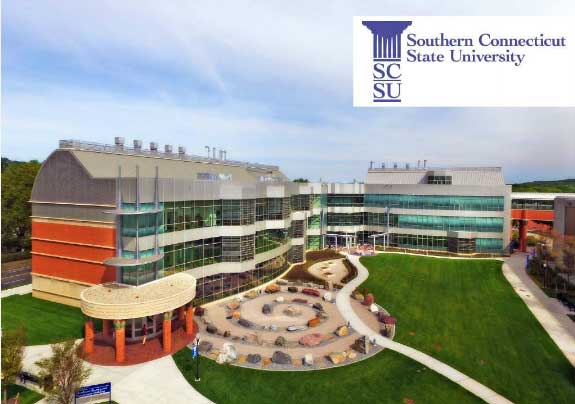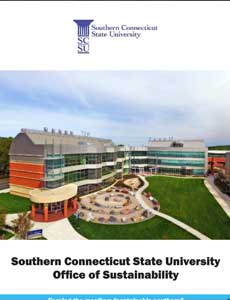SOCMA – Society of Chemical Manufacturers & Affiliates
Earning the moniker: “sustainable southern”
Southern Connecticut State University (nicknamed “Southern”), is located in New Haven, Connecticut, and is one of 17 institutions in the Connecticut State Colleges and Universities System. Founded in 1893 as a teacher’s college, Southern may be the system’s third-oldest campus, but its current community of some 11,000 students, faculty, and staff certainly isn’t living in the past. In fact, as a recognized leader in teaching and promoting a wide array of sustainability concepts and programs, and for its strong commitment to “going green,” this is one school that has vigorously embraced the needs of the present in order to assure a more balanced relationship with the environment, as well as a healthy and sustainable future.
Suzanne Huminski is Southern’s Sustainability Coordinator and a proud alumna. As the capstone project for her 2010 master’s degree in Environmental Education, she helped “kick-start” the university’s Sustainability Office and drafted its Climate Action Plan, part of the carbon neutrality pledge that Southern made in 2007 as a charter signatory to the American College and University Presidents Climate Commitment (ACUPCC).
According to Dr. Susan Cusato, a long-time Southern faculty member in Environmental, Geography, and Marine Sciences, Southern’s path to recognition in 2014 by the Princeton Review as one of the 332 most environmentally responsible colleges in the United States and Canada began via a bottom-up dynamic. “It was a group of students – an undergraduate environmental club – that actually went to the President’s office and requested that she sign the President’s Climate Commitment,” she relates. “That was strictly a student-organized and focused event and thanks to them, we do have that long history of being an early signatory to the Climate Commitment.”
In a similar way, Huminski credits an enlightened administration, faculty, and staff for embracing sustainability concepts throughout the campus and expanding the Sustainability Office’s scope and reach. “Students have always been involved,” she says, “but Facilities Operations and Southern’s executive leadership are also a driving force in adopting sustainability. Effective leadership is critical to success. This was not something that students had to rally for years and years to finally get movement on. Our Executive Vice President at the time and our Associate Vice President both invited students, faculty, and other staff to join the Sustainability Committee, and to participate in planning and implementing campus greening projects.”
Robert Sheeley is Southern’s Associate Vice President for Facilities Operations and Capital Budgeting. He has co-chaired the university’s Sustainability Committee since it was formed in 2007. Of the climate commitment, he says: “We signed on to the Presidents Climate Commitment in 2007 without a clear vision of what a thriving net carbon neutral campus could look like. The pledge truly was a leap of faith from the facilities perspective, and is still a developing field. Back in 2007, renewable energy was prohibitively expensive, energy efficiency technology was much more limited, and there were nowhere near as many products we could recycle in a logistically feasible or financially responsible way. That has been changing quickly. I used to worry that I’d run out of ‘low hanging fruit’ to balance some of the cost of bigger projects, but the rate and variety of innovation – both in technology and financing – is telling me we’ll have choices for a long time.”
Huminski elaborates further upon Southern’s maturation process regarding the relatively “new” arena of campus sustainability programs: “Sustainability has gone through a really interesting mainstreaming process,” she explains. “It has evolved as a field. Whereas it may originally have been a revolutionary concept where students were creating demands for change, now sustainability has turned into a set of leadership and process challenges, where we can take well-established management strategies and create sustainable outcomes. Overall, innovation is an incremental process.”
Regardless of how the initial impetus arose, or how it developed over the past several years, it is abundantly clear that the combined energy and efforts of Southern’s students, faculty, administration, and staff in promoting and extending sustainability, and inculcating its concepts into every area of campus life, have helped earn the university its new nickname, “Sustainable Southern.”
Southern’s president, Dr. Mary Papazian, puts it this way: “We have been working very hard as a university to adopt and develop sustainability in ways that help us address our most pressing institutional challenges. Sometimes sustainability is characterized as ‘doing well by doing good,’ and we’ve taken that to heart. Sustainability is a unifying principle throughout our new 10-year University Strategic Plan, and we also articulate it as a goal with specific action items and indicators of progress. The Presidents Climate Commitment is a bold pledge. Carbon neutrality will take years of planning and hard work to reach, but it provides a pathway and a range of approaches that are essential tools for our present and future well-being as a public university.”
One of the Plan’s stated goals is to “Transform the physical environment and infrastructure of the university and expand the university’s position as a nationally recognized leader in sustainability.” Action steps articulated in the plan will help Southern reach that goal and include: expanding upon and promoting best practices in waste reduction and recycling; extending the life and energy efficiency of existing facilities; and integrating LEED planning concepts into all aspects of the university’s built environment, requiring that all major new construction and renovation projects are to be at least LEED Silver Certified.
LEED Certification is something that is very-well known to Eric Lessne, the college and university system’s Associate Director of Planning and Engineering for the past 17 years. He talks about Southern’s many sustainable building projects: “We have a brand new science building that is in the process of going through LEED Certification, and we believe we’re going to hit Gold on it.” (That science building also has a 40,000 gallon, underground cistern to collect rainwater from the roof to be used for non-potable building purposes and irrigation.) “Our School of Business is certified Gold, and with all our major projects, we strive for 21 percent efficiency or greater in design,” he continues. “That alone saves us operating costs and helps to lower our carbon footprint. We’ve done a bunch of lighting retrofit programs, going into gymnasiums and classrooms to install as much LED (Light Emitting Diode) infrastructure as possible. We’ve done induction lighting in buildings and some of the parking lots, which is very cost-effective.
“Right now, our biggest efficiency projects are ‘retrocommissioning,’” he adds. Retrocommisioning is a systematic process for identifying less-than-optimal performance in a facility’s equipment, lighting, and control systems and making the necessary adjustments. Southern has partnered with United Illuminating and Ameresco to use Building Dynamics wireless sensing and online analytics to optimize all of the automated settings and building controls in two large buildings. Lessne continues: “We’ve done our Student Center and we’re in the process of recommissioning our largest classroom building, Engleman Hall (200 thousand square feet). Next we’ll take a look at a project that had a two-phase construction period over about eight and a half years, Buley Library. That library is 220 thousand square feet. These buildings each have literally hundreds of sensors and automated settings, and are too complex for one building operator to maximize savings.” To date, the school is saving more than $200,000 a year in energy costs due to retrocommissioning efforts and large lighting projects.
Funding for these capital improvement projects comes from a variety of sources, including the school’s operating budget; an auxiliary fund generated from student fees, which is used for housing, parking garages, and dining facilities; and general obligation bonds. In addition, Southern teams up with its utility company, United Illuminating. “We allocate the utility rebates to a revolving account,” Lessne explains. “Rebates go in, and we turn around and send it back out as another energy efficiency project. This accelerates our carbon reduction.”
“United Illuminating is unique for sustainability efforts,” notes Huminski. “Our partnership extends beyond just getting rebates. They have helped us identify many efficiency opportunities, and they also have their own sustainability program. This fall we’ll collaborate with them and Celtic Energy Consulting to update our climate action plan and create some action steps that will reduce our carbon emissions 20 percent below our 2008 benchmark. We’ll invite students to participate, offering four undergraduates a fellowship opportunity to develop professional skills in energy planning and management.”
Heather Stearns is Southern’s Recycling Coordinator and runs the Sustainability Office with Huminski. Says Stearns: “The school has been very proactive with recycling and waste reduction. We recycle everything from the more ordinary “single-stream” waste, which is the co-mingled paper products, plastics, and metal containers that are placed in campus recycling bins, to mattresses, batteries, construction materials, bulky items, e-waste, and unused paint. The university also has 13 new refillable water stations and three EV recharging stations for electric cars. Even more than recycling, our goal is waste reduction – not creating the waste in the first place.” In that vein, Stearns created and students manage the Swap Shop, a free office supplies exchange. “Our ‘shoppers’ are mostly office interns and administrative assistants in different departments and offices,” says Stearns. “We have an online inventory, as well as an actual location. We have binders, printer ink, pens and pencils, folders, staplers, shredders, tape, thumbtacks, and much more. We track inventory and savings. In two years, the Swap Shop has saved the university $60,000, and we have another $37,000 in the current inventory. It is a really important, hands-on, waste reduction project for students, and if we hadn’t started it, nobody would have paid much attention to the savings opportunity.”
“Southern students plant, maintain, and manage volunteers at the campus community garden, and most of the produce that’s grown there is donated to soup kitchens in the city,” Huminski says. The Geo Club has adopted sustainability as its mission, and they are the heart of many projects and initiatives on campus. For example, they collect compostable food scrap from volunteer offices and departments across campus and use it to fertilize the garden. They call this project “Compost Happens!”
A more wide-reaching initiative is the New Haven Urban Oasis Project, a city-wide partnership with several community and national organizations, such as the New Haven Land Trust, the U.S. Fish and Wildlife Service, Audubon Connecticut, and Yale University’s Urban Resource Initiative. “We’re helping develop a corridor of bird and pollinator-friendly habitats that connect larger open spaces that border the city to provide habitat for birds and pollinators, and encourage community involvement and awareness,” says Huminski. “Because of our position in the northeast flyway, New Haven has been recognized as one of 12 national, urban wildlife refuges. That’s one of the bigger collaborative efforts that we’ve been working on through the Office of Sustainability. We also established a residential living learning community themed around sustainability, and just started a chapter of the Food Recovery Network on campus. Students are collecting foods that have reached their ‘best by’ dates at campus retail locations to donate at local shelters and soup kitchens.”
Southern’s Werth Center for Coastal and Marine Studies is the recipient of the largest donation in the school’s history, supporting both faculty and undergraduates who are actively involved in current research efforts. “One of the major Werth Center research projects, conducted by Dr. James Tait and student fellows, is to survey Connecticut’s beaches, to create and maintain erosion profiles, and to assess vulnerability to future storm-wave damage. Cities and towns nearby are using their research, as is FEMA (Federal Emergency Management Agency), to create maps and coastal management plans as well as sea-level rise resilience plans. The research is sorely needed, and this type of planning hasn’t been done before,” Huminski says.
It’s unlikely that Southern would be so deeply involved in so many long-range and complex sustainability and environmental projects if the school hadn’t integrated sustainability principles and concepts throughout the broader academic curriculum for many years. As Dr. Cusato makes clear, “Southern has had a long history of being at the forefront of environmental education and recognizing the importance of environmental literacy for our students. Our geography program is very closely tied to sustainability, and offers a sustainability concentration. We have one of the only Environmental Education graduate programs in New England. Our master’s graduates have pursued and taken jobs in the energy field, the utilities field, and the legislature, with emphasis on environmental sustainability issues. The great majority of Environmental Education alumni teach in our state’s school districts, creating awareness for Connecticut’s youth about environmental issues and solutions.”
Cusato continues, “During the last 15 years or so, we have built up two undergraduate minors, Marine and Environmental Studies. Because of their success, we are in the approval process for creating an interdisciplinary undergraduate major – Environmental Systems and Sustainability. With three tracks — Environmental, Marine, and Policy and Management — the major will include courses in business, geography, environmental studies, marine studies, biology, public health, sociology, political science. Students with a broad range of interests can find a way to integrate sustainability into their studies.”
Finally, Huminski asserts that her office works hard to support student involvement in all its sustainability projects. “Student creativity and energy are very valuable assets to the university,” she asserts. Dr. Cusato adds her desire to see Southern as a living laboratory with lessons that can be learned and subsequently applied over a lifetime: “I hope that Southern is a model for students to see sustainability integrated throughout the campus, whether it’s refilling their water bottles at a refill water station or the campus dining facilities, or the place to recharge a car in the facilities building, or the way they’re learning professional skills through a curriculum infused with sustainable principles. I don’t want them to view sustainability as something you just take a class in or do at a particular time. I want them to understand their campus experience as an opportunity to model sustainable practices and principles throughout a community, and then extend to their personal and professional lives after graduation.”
Based on all that Southern Connecticut State University has accomplished in the fields of sustainability practices and environmental studies, it’s clear that it has rightfully earned its new moniker: “Sustainable Southern.”
______________________________________
AT A GLANCE
WHO: Southern Connecticut State University Office of Sustainability
WHAT: A recognized leader in teaching and promoting a wide array of sustainability concepts and programs
WHERE: New Haven, Connecticut
WEBSITE: www.southernct.edu/about/sustainability
PREFERRED VENDORS
Seldera, LLC – www.seldera.com


